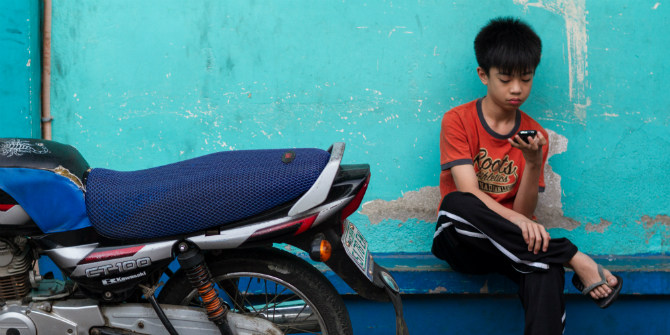 Can children develop digital resilience without first experiencing risky experiences online? And do risky online experiences always result in children becoming more digitally resilient afterwards? For www.parenting.digital, Simon P Hammond discusses his new publication on how best to support children in developing digital resilience.
Can children develop digital resilience without first experiencing risky experiences online? And do risky online experiences always result in children becoming more digitally resilient afterwards? For www.parenting.digital, Simon P Hammond discusses his new publication on how best to support children in developing digital resilience.
You may have seen the Yin-Yang symbol before – the dark and light swirls complementing and completing each other, each containing elements of the other. The same may be said about online risk and resilience. Conceptually, digital resilience may be acquired via controlled exposure to online risks. Does it follow then, that a lack of exposure to online risks impedes the development of digital resilience?
No, that is not what I am suggesting for a few reasons. Firstly, there is the need to challenge the assumption that online risk leads, by default, to online harms. Risks and harms from these are conceptually different phenomena. Secondly, controlled exposure is different from total uncontrolled exposure. Teaching a child to learn how to ride a bike in a park is different from teaching them on a motorway. Thirdly, with the majority of homes with children aged 0-17 years old having internet access (97%) and survey data indicating that the majority of 8-12-year-olds report experiencing online risks, risk is pretty much inevitable. However, as the Yin-Yang symbol indicates, everything contains the seed of the other. So, there is a need for balance?
Digital resilience, the Yang to risk’s Yin?
Digital resilience is a process through which people and groups can come to learn how to recognise, manage, and recover, following risky online experiences. However, if and how children may benefit following risky online experiences depends on the child and the relationships and systems surrounding them. This means that knowing how to support children to be digitally resilient when facing online adversity is an increasingly important part of growing up, parenting and education. We know that Pan-European research shows that resilience development can be supported by enhancing children’s digital skills. We also know that higher digital skills can help prevent risky online experiences from becoming harmful ones in turn supporting digital resilience development. Importantly, evidence also shows us that children who engage in more online activities tend to experience more online risks. Hence, how we come to understand how we support children across their home, community, and societal contexts to learn how to recognise, manage, recover, following risky online experiences is vital yet remains unclear. Without this understanding, the challenge of supporting children to flourish online becomes even harder.
Whilst digital resilience is not a new concept, it is one which we know remains conceptually embryonic. That’s why my colleagues and I conducted a systematic review and meta-ethnography. The study, recently published in New Media and Society, aimed to robustly synthesise existing evidence regarding children’s, parents’, educators’, and civil society actors’ experiences of digital resilience to advance our understanding of this important idea.
The process of building digital resilience
After examining over 8,000 articles, we propose that digital resilience-building processes operate, and are influenced, across and by micro-level (individual and home) and macro-level (community and society) systems. Relatedly, we argue that each independent, yet interconnected system needs to constantly balance risky opportunities that enable children to build and show digital resilience.
In our study, we report four themes ‘using connective technologies’, ‘risky online experiences’, ‘mediation strategies’ and ‘risk and protective factors’. In drawing these themes together, our analysis created the overarching or line-of-argument theme of ‘constant balancing’. Within this theme, we argue that seemingly dichotomous factors, such as ‘using connective technologies’ and ‘risky online behaviours’, were occurring simultaneously and that constant balancing across individual, home, community and societal levels is required to enable opportunities for optimal digital resilience development. One cannot have risky online experiences, we argue, without the potential to develop digital resilience and vice versa.
There is no Yang without Yin, nor Yin without Yang. As the following evidence-informed animation shows, supporting children to learn how to recognise, manage, and recover following risky online experiences is just like learning to ride a bike, it’s about constant balancing.
First published at www.parenting.digital, this post represents the views of the authors and not the position of the Parenting for a Digital Future blog, nor of the London School of Economics and Political Science.
You are free to republish the text of this article under Creative Commons licence crediting www.parenting.digital and the author of the piece. Please note that images are not included in this blanket licence.
Featured image: photo by Monstera Production on Pexels






